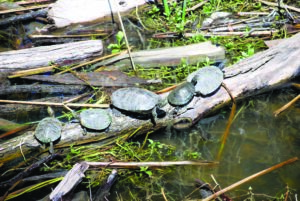By Dr. Beth Leermakers
When my lab swims in the pond at the dog park, I look for turtles before I throw her ball. I often see turtles pop under the water when my girl enthusiastically launches herself into the pond. I’m not sure they’d bite her, but I’m not taking any chances.

Photo courtesy of WRLW reader Bonddaniel70@yahoo.com
Those brave turtles are probably red-eared sliders, the most common aquatic turtles in Texas. Their name comes from the broad red stripe behind their eye and their habit of sliding off a log or rock when they’re startled. Red-eared sliders have a top speed of 12 mph — much faster than my dog.
Let’s look at these fascinating prehistoric reptiles. Turtles are:
Well designed for survival. Turtles are some of the oldest reptilian species on the earth, virtually unchanged in more than 200 million years. The traits that helped them out-survive the dinosaurs still work for turtles. Yale University researchers believe turtles survived the mass extinction that wiped out the dinosaurs because of turtles’ slow metabolisms and aquatic lifestyles. Animals that lived in the water were protected against whatever killed the land plants and dinosaurs. Their slow metabolism allowed turtles to survive on the limited food available during and after the global extinction event (probably caused by a meteor strike) that killed the dinosaurs.
Sun bathers by necessity. Unlike birds and mammals, turtles are ectothermic, or coldblooded. They rely on the temperature around them to regulate their body temperature. Turtles spend hours basking on a log or rock to warm their bodies. Like most ectothermic animals, they don’t tolerate radical temperature swings well.
Well protected. Because turtles are slow, they depend on their shell to defend against predators. Turtle shells are extremely hard — strong enough to withstand thousands of pounds of pressure. A turtle’s shell is made of more than 50 connected bones that fuse together the turtle’s spine and rib cage. The top of the turtle’s shell is covered by square plates called scutes (made of keratin, like fingernails). The shell grows as the turtle grows, and turtles cannot leave their shell.
Baby makers — not care-givers. Female turtles dig a hole in the ground, lay their eggs and leave. Baby turtles must take care of themselves from day one. Talk about tough love!
Endangered. Almost half (129) of approximately 300 species of turtle and tortoise on Earth today are either vulnerable, endangered or critically endangered. Turtles and tortoises are threatened by loss of habitat, pollution, poaching and the illegal pet trade.
Could a tortoise beat a hare? Probably not —unless the hare took a long nap during the race. Tortoises (terrestrial animals with clubbed feet instead of turtles’ webbed feet) crawl at speeds of 0.13 to 0.30 miles per hour. Turtles move more quickly, walking 3-4 mph and swimming 10-12 mph. The hare is one of the fastest mammals, running 35-50 mph in short bursts.
Many turtles cross roads in the late spring and summer. They are females looking for a nesting site. To prevent turtles from getting hit by a car, carry them across the road in the same direction they were traveling. If you don’t, the turtle will just try to cross the road again. Do NOT relocate a turtle to a different area. They have small territories and need to stay where they are. Box turtles won’t settle into a new area. Instead, they will wander aimlessly, trying to find their old home, until they die.
Don’t keep a wild turtle as a pet. Most wild animals make very poor pets and are best observed in their native habitat. If you find an injured turtle, put it in a box and call the DFW Wildlife Hotline: 972-234-9453 (WILD). Remember where you found the turtle so it can be released back there after it has healed.
Most turtle species live for 30-40 years. The oldest turtle, named Tu’i Malila, of Tonga Island, lived for 188 years. Turtles need a lot of space. Turtles continue to grow throughout their lifetime, and they need plenty of room to roam.
Turtles can transmit salmonella to people. Always wash your hands after handling a turtle.
